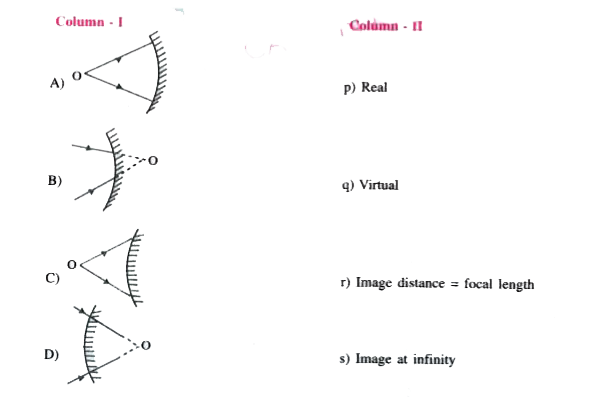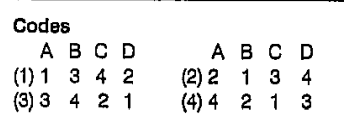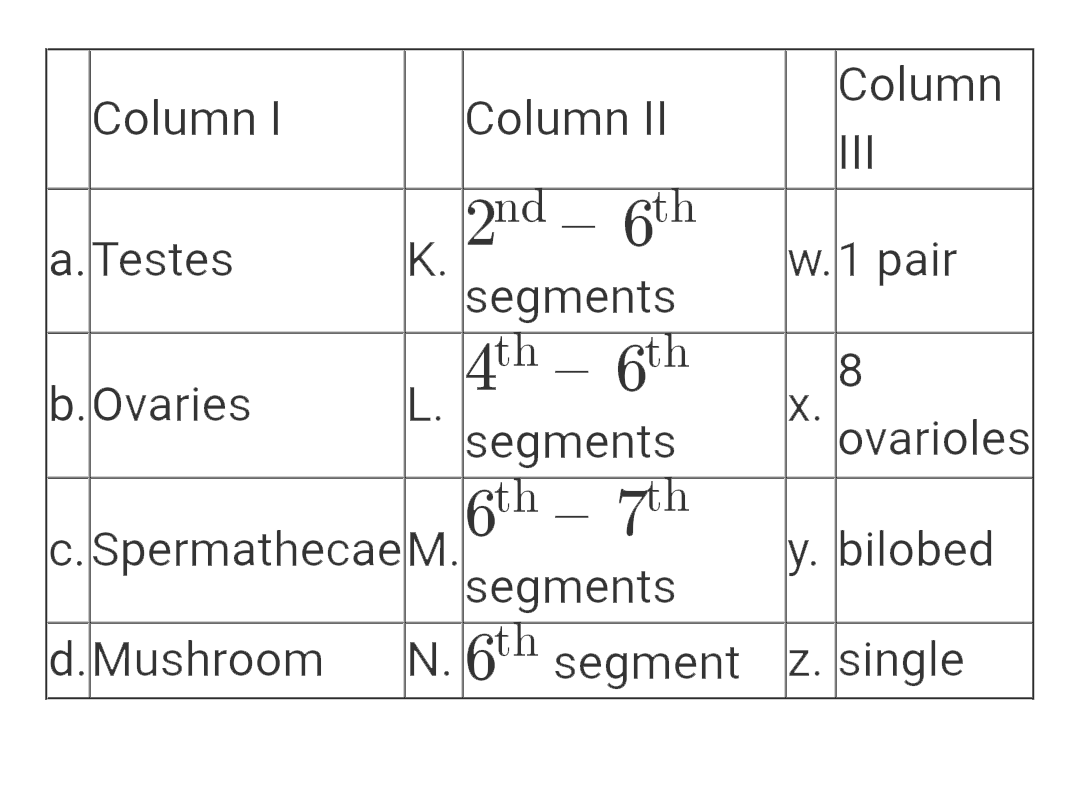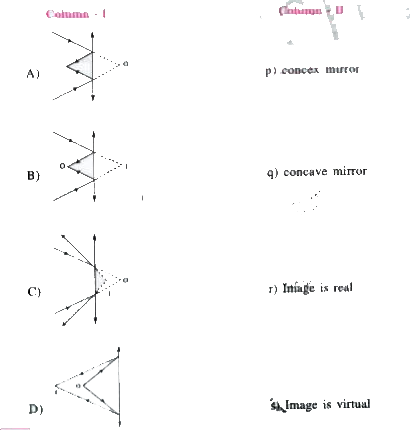The given situations in Column - I, choose the possible options from Column - II regarding the image formed when u≠∞ (u is the object distance from the pole of the mirror)

The correct Answer is:A, B, C, D
Topper's Solved these Questions
- GEOMETRICAL OPTICSBOOK - AAKASH SERIESCHAPTER - GEOMETRICAL OPTICSEXERCISE - LECTURE SHEET (EXERCISE-I (LEVEL-II (ADVANCED) INTEGER TYPE QUESTIONS))
2 Videos
- GEOMETRICAL OPTICSBOOK - AAKASH SERIESCHAPTER - GEOMETRICAL OPTICSEXERCISE - LECTURE SHEET (EXERCISE-II (LEVEL-I (MAIN) STRAIGHT OBJECTIVE TYPE QUESTIONS))
17 Videos
- GEOMETRICAL OPTICSBOOK - AAKASH SERIESCHAPTER - GEOMETRICAL OPTICSEXERCISE - LECTURE SHEET (EXERCISE-I (LEVEL-II (ADVANCED) LINKED COMPREHENSION TYPE QUESTIONS))
5 Videos
- ELEMENTS OF VECTORSBOOK - AAKASH SERIESCHAPTER - ELEMENTS OF VECTORSEXERCISE - QUESTIONS FOR DESCRIPTIVE ANSWERS
9 Videos
- LAWS OF MOTIONBOOK - AAKASH SERIESCHAPTER - LAWS OF MOTIONEXERCISE - PRACTICE EXERCISE
98 Videos
Similar Questions
Knowledge Check
Here in Column I position of the object and in Column II position of the image for a mirror reflection is given. Match the columns.
 A
A B
B C
C D
D
If u represents object distance from pole of spherical mirror and u represents image distance form pole of mirror and f is the focal length of the mirror. Then a straight line u = u will cut u versus v graph at
A( f, f )B(2f ,2f)C(f,2f)D(0,0)
Match the options of the following columns.
Column IColumn IIFor real extended object,if image formed by a single mirror is erect, and if the size of image is smaller than object, the mirror is(P)ConcaveFor real extended object, if the size image is smaller than object, the mirror is(Q)ConvexFor real extended object, if image formed by asingle mirror is erect and if the size of image is larger than object, then mirror is (R)(f,f)For spherical mirrors, a line u=v will cut the curve between u and v at a point.(S)(2f,2f)

View SolutionMatch the columns I, II and III , and choose the CORRECT combination from the options given regarding Cockroach

View SolutionMatch the columns I, II and III , and choose the CORRECT combination from the options given regarding Cockroach

View SolutionColumn IColumn II(A) As object is approaches from x = oo to x = R ,the image approaches the pole . The mirror must be(p)convex(B)As object approches from x = R//2 to x=0 , then the image approaches the pole. The mirror may be(q) concave(C)The speed of the object is u , then if mirror is concave the speed of the image is (r)(RR+2x)2u(D) The speed of the object is u , then if mirror is convex then speed of the image is (s)(RR−2x)2u
View SolutionColumn IColumn II(A) As object is approaches from x = oo to x = R ,the image approaches the pole . The mirror must be(p)convex(B)As object approches from x = R//2 to x=0 , then the image approaches the pole. The mirror may be(q) concave(C)The speed of the object is u , then if mirror is concave the speed of the image is (r)(RR+2x)2u(D) The speed of the object is u , then if mirror is convex then speed of the image is (s)(RR−2x)2u
View SolutionColumn I contains the path traced by light rays abnd the positions of object and image, with a reflecting spherical mirror. Choose the possible for type of mirror and the nature of image rom column II to each case in column -I

View Solution


